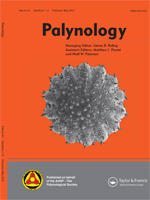Monthly corbicular samples derived from weekly collections of Melipona (Melikerria) interrupta (Apidae: Meliponini) were analyzed alongside a single honey sample between January to December 2012. The botanical families Arecaceae, Melastomataceae and Solanaceae were the most representative in the corbicular load samples, with five temporary specialization events (>90%) being detected for representatives of Melastomataceae and Solanaceae. Furthermore, Melastomataceae also exhibited a greater contribution of pollen types in the honey samples, particularly because of the occurrence of Miconia type (87.17%), followed by Solanaceae, represented by types Solanum stramonifolium (5.00%) and Solanum aculeatissimum (2.50%). The low richness of pollen types in the corbicular pollen samples (n = 16) in this study suggests that M. interrupta may act as a specialist due to the low availability of apiculture resources in terra-firme environments, where intraspecific competition might affect not only the maintenance of these colonies in this environment but also their honey production.
How to translate text using browser tools
1 April 2018
Pollen Niche of Melipona (Melikerria) Interrupta (Apidae: Meliponini) Bred in a Meliponary in a Terra-Firme Forest in the Central Amazon
Marcos Goncalves Ferreira,
Maria Lucia Absy
ACCESS THE FULL ARTICLE
It is not available for individual sale.
This article is only available to subscribers.
It is not available for individual sale.
It is not available for individual sale.

Palynology
Vol. 42 • No. 2
May 2018
Vol. 42 • No. 2
May 2018
AMAZON
pollen
stingless bees
terra-firme
trophic resources





